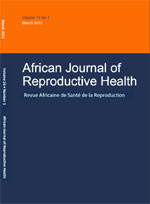
|
African Journal of Reproductive Health
Women's Health and Action Research Centre
ISSN: 1118-4841
Vol. 13, No. 2, 2009, pp. 87-95
|
 Bioline Code: rh09025
Bioline Code: rh09025
Full paper language: English
Document type: Research Article
Document available free of charge
|
|
|
African Journal of Reproductive Health, Vol. 13, No. 2, 2009, pp. 87-95
| en |
Prevention of Postpartum Hemorrhage: Options for Home Births in Rural Ethiopia
Prata, N.; Gessessew, A.; Abraha, A. K.; Holston, M. & Potts, M.
Abstract
This paper sought to determine the safety and feasibility of home-based prophylaxis of postpartum
hemorrhage (PPH) with misoprostol, including assessment of the need for referrals and additional
interventions. In rural Tigray, Ethiopia, traditional birth attendants (TBAs) in intervention areas were
trained to administer 600mcg of oral misoprostol. In non-intervention areas women were referred to the
nearest health facility. Of the 966 vaginal deliveries attended by TBAs, only 8.9% of those who took
misoprostol prophylactically (n=485) needed additional intervention due to excessive bleeding
compared to 18.9% of those who did not take misoprostol (n=481).The experience of symptoms among
those who used misoprostol can be considered of minor relevance and self-contained. This study found
that prophylactic use of misoprostol in home births is a safe and feasible intervention. Community
health care workers trained in its use can correctly and effectively administer misoprostol and be a
champion in reducing PPH morbidity and mortality (Afr J Reprod Health 2009; 13[2]:87-95).
Keywords
Misoprostol; postpartum hemorrhage; traditional birth attendants (TBAs)
|
| |
| fr |
La prévention de l’hémorragie du post-partum: options pour les naissances à domicile en Ethiopie rurale
Prata, N.; Gessessew, A.; Abraha, A. K.; Holston, M. & Potts, M.
Résumé
Cette étude avait pour objectif de déterminer la sauveté et la faisabilité de la prophylaxie adaptée
localement de l’hémorragie du post-partum (PHP) à l’aide de misoprostol, y compris l’évaluation de la
nécessité des orientations vers les spécialistes et des interventions supplémentaires. A Tigray, en
Ethiope, les sages-femmes traditionnelles (SFT) dans les régions de l’intervention ont été formées pour
administrer 600 mcg de misoprostol par voie orale. Dans les régions où il n’y pas d’intervention, on a
orienté les femmes vers un établissement de santé le plus proche. Sur les 996 accouchements par voie
vaginale que les SFT ont fait accoucher, seul 8,9% de celles qui ont pris misoprostol
prophylactiquement (n=485) avaient besoin d’une intervention supplémentaire à cause de l’hémorragie
excessive par rapport à 18,9% de celles qui n’ont pas pris misoprostol (n=481). L’expérience de celles
qui ont pris misoprostol ne peut pas être considérée come étant d’une pertinence mineure ou autonome.
Cette étude a découvert que l’emploi prophylactique de misoprostol dans les accouchements à domicile
est une intervention sans danger et faisable. Les membres du personnel soignant de la communauté qui
ont été formés de la manière de l’employer, peuvent administrer misoprostol effectivement et de bonne
manière et peuvent être des champions dans la réduction de la morbidité et la mortalité de la PHP (Afr J
Reprod Health 2009; 13[2]:87-95).
|
| |
© Copyright 2009 - Women's Health and Action Research Centre
Alternative site location: http://www.ajrh.info
|
|
